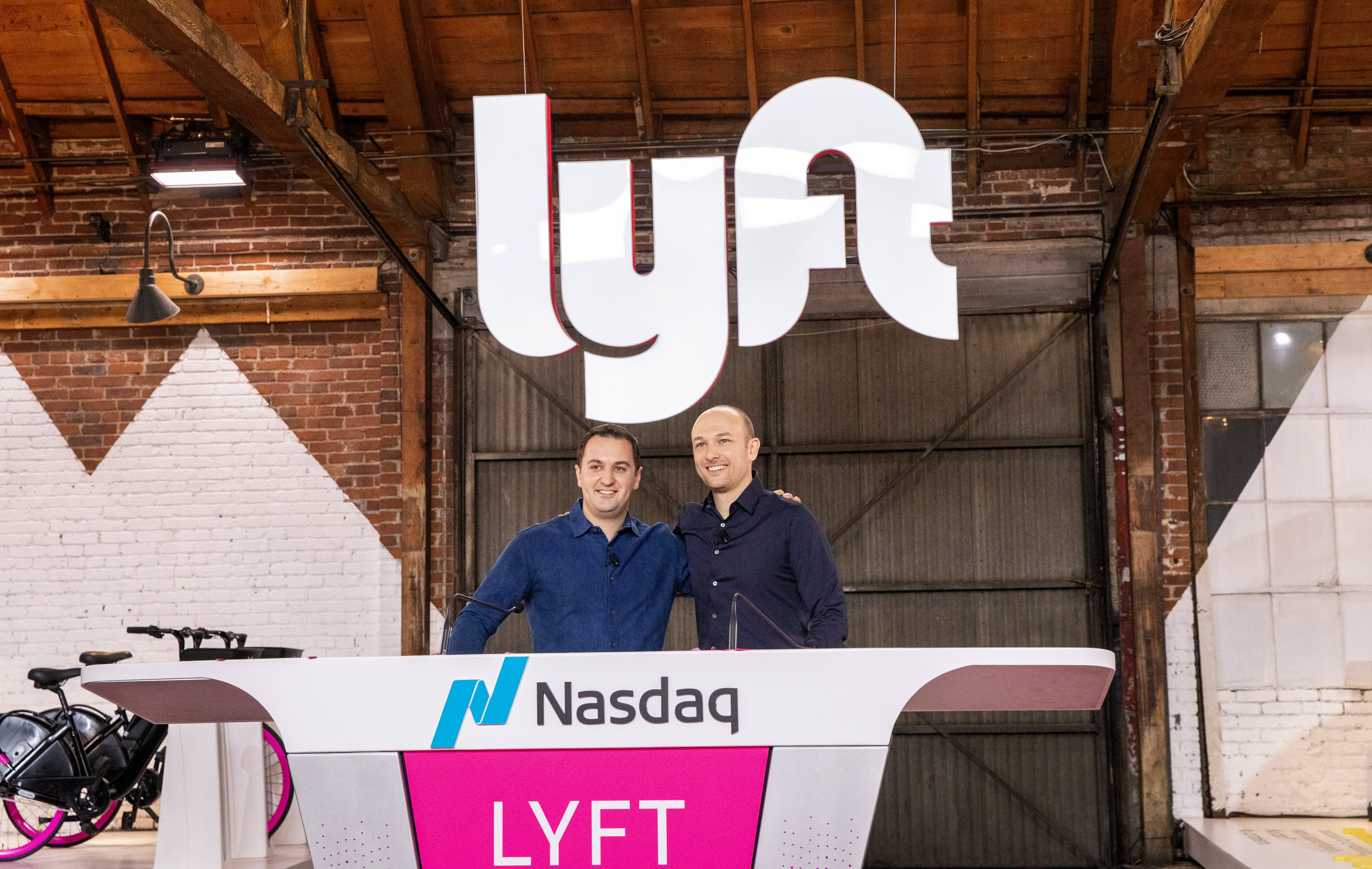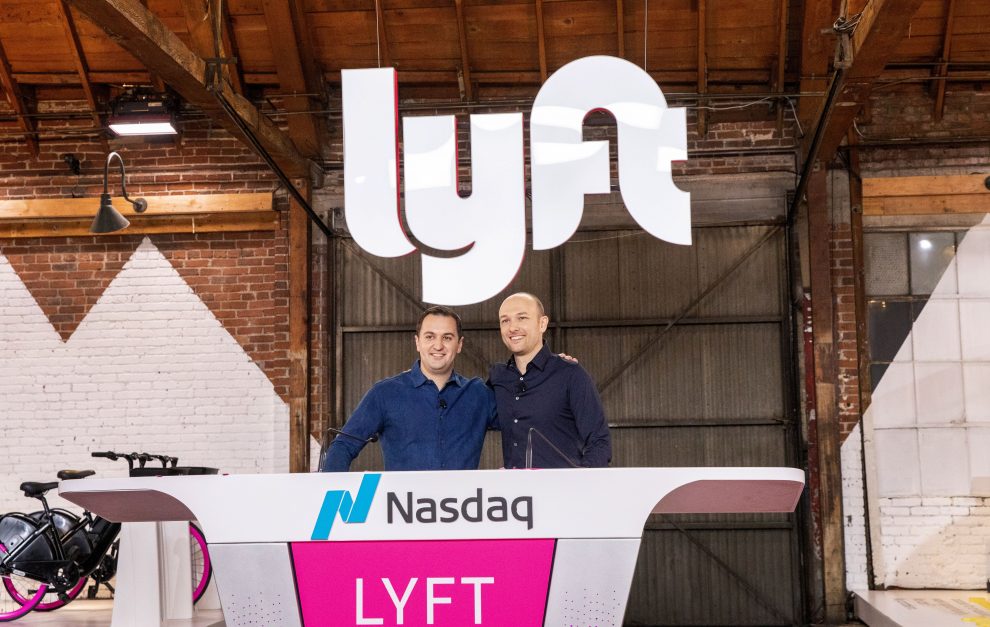
In late March, Lyft’s co-founder John Zimmer told CNBC — on the Friday morning when the rideshare firm went public and he earned hundreds of millions of dollars — that the company was “ready to be held accountable” for the fact that it had no history of profits. The market did not wait long. After finishing up modestly on its first day of trading, it has been almost all downhill for the company, with shorts piling into the stock and a loss for Lyft investors near-30% below its first-day closing price.
Lyft’s IPO was the first in a heralded crop of Silicon Valley unicorns expected to test the public markets this year, and on Tuesday it gets to take a crack at another market first: reporting earnings as a public company —or in its case, a big loss — with its first-quarter financials expected after the market close.
As Lyft has tanked, the stock market has continued to reach new highs, and other closely watched tech IPOs have fared far better, with Pinterest still well above its first-day trade and Zoom Video soaring.
“Let’s not sugarcoat it; Lyft’s stock has been a head-scratching train wreck since the IPO,” said Dan Ives, managing director at Wedbush Securities. “The first quarter coming out of the box for any company is so important after going public, but for this one it is incrementally a key factor, just given Street fears. It is unusual for the bloom to come off rose so quickly, and that is why it is such a prove-me quarter.”
Lyft co-founders John Zimmer (L) and Logan Green (R).
One thing no one expects is a profit. That may not arrive until earliest 2022, according to early Lyft investor Santosh Rao, partner at Manhattan Ventures.
Ives expects a loss per share of $5.60. He has lowered his price target on the stock from $80 to $67, but it has nothing to do with the EPS.
Raymond James wrote in an earnings preview: “We expect 2019 to be the peak EBITDA loss year at $1.3 billion, reflecting investments in bikes and scooters and other growth initiatives.”
Lyft’s founders have made it clear that they will continue to invest for the long term, telling CNBC amid the fanfare of the company’s first trading day that they would not be doing the right thing if they were focused on the next one or two years. “We are focused on the next three, four, five,” Zimmer said.
With investors expecting the losses to mount, the focus will be on a limited set of growth metrics: the top-line (revenue), active riders and revenue per rider.
“If there is any hint of softness in any metric, in terms of guidance, it could be dark days ahead,” Ives said. “The whisper numbers have started to come down, and that is part of why the stock has acted as it had. The shorts have had a field day.”
Profitability is allowed to continue to be murky, he said, “but if you get a sense that maybe there are some cracks in the armor around growth metrics and the forecast going forward is strong but doesn’t meet the whisper expectations with a company that won’t be profitable before man lands on Mars, that combination could spell trouble for the stock.”
Lyft shares closed down 3% on Monday, at $60.57.
For the next four to six quarters, it will be a maniacal focus purely on the metrics, revenue growth and how it looks relative to expectations.
Dan Ives
Wedbush Securities managing director
Raymond James is among the most bullish sell-side firms into earnings, maintaining an $85 target on Lyft shares and expecting the report to generate upside, even though it is not looking for heroic forward-looking numbers. It sees revenue of $745 million in Q1 (+87.5% year-over-year) versus a Wall Street consensus of $740 million, driven by an increase in active riders of 41% year-over-year and revenue per active rider up 34% year-over-year.
Raymond James analysts think Q2 revenue will come in below Street expectations of $788 million (it has revenue pegged at $765 million, a 52% year-over-year increase), but it is betting the market won’t view that as a disappointment, because the Street consensus has been skewed by several outliers. It also expects Lyft to provide a conservative outlook due to pricing pressures.
But even in maintaining its $85 price target, it is expecting investors to be wary. “It may take a quarter or two for investors to be comfortable with market rationalization, but we believe Lyft’s multiple will expand when that occurs; a rational market lessens competitive fears and makes lapping 2018’s tough comps easier,” Raymond James analysts wrote. (The company was able to charge higher prices in Q2 2018.)
The focus from investors on growth metrics for a company expected to lose more than $1 billion this year may not be a one-quarter event.
“For the next four to six quarters, it will be a maniacal focus purely on the metrics, revenue growth and how it looks relative to expectations,” Ives said. “Right now they are in stealth growth mode, investing in the business and increasing riders and bookings and to really give investors more comfort that they are a net-share gainer and have monetization capabilities. … It comes down to metrics and bookings to drive that.”
Several of the firms covering Lyft have Q2 revenue estimates that are in a tight range, expecting an increase slightly above 50% from year-ago levels. Raymond James and Cowen anticipate revenue of $765 million; Wedbush is at $767 million.
Cowen analysts think the pullback is “overdone” and Lyft’s valuation is attractive; it has a price target of $77.
“We expect shares to get back on track and view solid earnings and 2Q19 guidance as a key catalyst to reaffirm Lyft’s position and remind investors of the massive opportunity [long-term],” its analysts wrote in a note to clients Friday. Cowen analysts advised investors to look for “strong 2Q19 guidance suggesting active rider and rev/rider growth momentum continue into the spring/summer months.”
It is forecasting active riders of 20.2 million in Q2, which would be a 31% increase from a year ago, and revenue per rider of $37.90, a 16% year-over-year increase.
Uber IPO looms
Potential headwinds Cowen foresees are margin pressure from Lyft investing heavily in bikes/scooters in the second quarter, and any impact from political issues including congestion pricing tax in New York City and continuing debate around driver wages (rideshare drivers have strikes planned around the country for Wednesday).
Ives said if driver strikes continue, minimum-wage laws for drivers becoming more common across the country, or Uber continues to place more pressure on prices, there will be additional headwinds for Lyft.
“Lyft has less flexibility than investors first thought, thought even a month ago. When Uber went from 80 cents to 60 cents in LA [right before the Lyft IPO], that was a big shot across the bow. The Uber business model is strong enough and broad enough in terms of 90-million-plus active riders, they can withstand a little more pressure on the model.”
The first Lyft earnings report comes just a few days before the anticipated IPO of its larger rival, Uber, on Thursday. “The shadow of the Uber IPO and roadshow continue to weigh on shares of Lyft,” Ives said.
Susquehanna International Group analysts, who maintain a neutral rating on Lyft and a price target of $57, wrote in a Lyft earnings preview that Q1 should be OK since Lyft management would have already set expectations conservatively during the IPO process, but they remain worried about Q2 coming in light compared to Street expectations, and said they remain worried about “industry dynamics. … The competitive dynamics of being the #2 player in a market where scale is extremely important.”
The SIG team pointed to options market activity through last Friday that indicated Lyft could swing by as much as 12.5% plus or minus on earnings, but more of the bets were being placed on the upside.
“This could be a step in the right direction for the company,” Ives said. “If I felt warm and fuzzy, I wouldn’t have lowered price targets. But if it’s good numbers, better than expectations, we could have significant short covering.”
Aswath Damodaran, a valuation expert at NYU’s Stern School of Business, told CNBC after Lyft’s IPO that valuation remains a measure that the growth story can’t justify. Lyft’s market cap was $17.3 billion at the close on Monday. That is down from a market cap that reached more than $26 billion on its first day, but it is still too high, according to Damodaran.
“My estimate, and I am bending every single rule to the breaking point, is I get to about $15 or $16 billion. You’ve got a business that lost a billion last year, hasn’t figured out how to make money yet, the business right now in rideshare is broken across the board, so getting to $15 billion was a stretch for me.”





